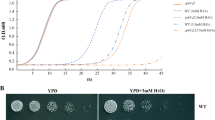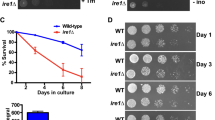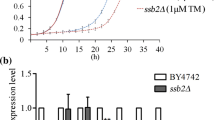Abstract
Pmt1p is an important member of the protein O-mannosyltransferase (PMT) family of enzymes, which participates in the endoplasmic reticulum (ER) unfolded protein response (UPR), an important pathway for alleviating ER stress. ER stress and the UPR have been implicated in aging and age-related diseases in several organisms; however, a possible role for PMT1 in determining lifespan has not been previously described. In this study, we report that deletion of PMT1 increases replicative lifespan (RLS) in the budding yeast Saccharomyces cerevisiae, while overexpression of PMT1 (PMT1-OX) reduces RLS. Relative to wild-type and PMT1-OX strains, the pmt1Δ strain had enhanced HAC1 mRNA splicing and elevated expression levels of UPR target genes. Furthermore, the increased RLS of the pmt1Δ strain could be completely abolished by deletion of either IRE1 or HAC1, two upstream modulators of the UPR. The double deletion strains pmt1Δhac1Δ and pmt1Δire1Δ also displayed generally reduced transcription of UPR target genes. Collectively, our results suggest that PMT1 deficiency enhances basal activity of the ER UPR and extends the RLS of yeast mother cells through a mechanism that requires both IRE1 and HAC1.




Similar content being viewed by others
References
Arroyo J, Hutzler J, Bermejo C et al (2011) Functional and genomic analyses of blocked protein O-mannosylation in baker's yeast. Mol Microbiol 79(6):1529–1546. doi:10.1111/j.1365-2958.2011.07537.x
Baudin A, Ozier-Kalogeropoulos O, Denouel A et al (1993) A simple and efficient method for direct gene deletion in Saccharomyces cerevisiae. Nucleic Acids Res 21(14):3329–3330
Boisson-Dernier A, Lituiev DS, Nestorova A et al (2013) ANXUR receptor-like kinases coordinate cell wall integrity with growth at the pollen tube tip via NADPH oxidases. PLoS Biol 11(11):e1001719. doi:10.1371/journal.pbio.1001719
Burtner CR, Murakami CJ, Olsen B et al (2011) A genomic analysis of chronological longevity factors in budding yeast. Cell Cycle 10(9):1385–1396
Chen D, Thomas EL, Kapahi P (2009) HIF-1 modulates dietary restriction-mediated lifespan extension via IRE-1 in Caenorhabditis elegans. PLoS Genet 5(5):e1000486. doi:10.1371/journal.pgen.1000486
Cox JS, Walter P (1996) A novel mechanism for regulating activity of a transcription factor that controls the unfolded protein response. Cell 87(3):391–404
Delaney JR, Ahmed U, Chou A et al (2013) Stress profiling of longevity mutants identifies Afg3 as a mitochondrial determinant of cytoplasmic mRNA translation and aging. Aging Cell 12(1):156–166. doi:10.1111/acel.12032
Gentzsch M, Tanner W (1996) The PMT gene family: protein O-glycosylation in Saccharomyces cerevisiae is vital. EMBO J 15(21):5752–5759
Girrbach V, Strahl S (2003) Members of the evolutionarily conserved PMT family of protein O-mannosyltransferases form distinct protein complexes among themselves. J Biol Chem 278(14):12554–12562. doi:10.1074/jbc.M212582200 M212582200
Gonzalez M, Brito N, Frias M et al (2013) Botrytis cinerea protein O-mannosyltransferases play critical roles in morphogenesis, growth, and virulence. PLoS One 8(6):e65924. doi:10.1371/journal.pone.0065924
Goto M (2007) Protein O-glycosylation in fungi: diverse structures and multiple functions. Biosci Biotechnol Biochem 71(6):1415–1427
Hamann T, Denness L (2011) Cell wall integrity maintenance in plants: lessons to be learned from yeast? Plant Signal Behav 6(11):1706–1709. doi:10.4161/psb.6.11.17782 17782
Harty C, Strahl S, Romisch K (2001) O-mannosylation protects mutant alpha-factor precursor from endoplasmic reticulum-associated degradation. Mol Biol Cell 12(4):1093–1101
Henis-Korenblit S, Zhang P, Hansen M et al (2010) Insulin/IGF-1 signaling mutants reprogram ER stress response regulators to promote longevity. Proc Natl Acad Sci U S A 107(21):9730–9735. doi:10.1073/pnas.1002575107
Henry KA, Blank HM, Hoose SA et al (2010) The unfolded protein response is not necessary for the G1/S transition, but it is required for chromosome maintenance in Saccharomyces cerevisiae. PLoS One 5(9):e12732. doi:10.1371/journal.pone.0012732
Immervoll T, Gentzsch M, Tanner W (1995) PMT3 and PMT4, two new members of the protein-O-mannosyltransferase gene family of Saccharomyces cerevisiae. Yeast 11(14):1345–1351. doi:10.1002/yea.320111403
Jonikas MC, Collins SR, Denic V et al (2009) Comprehensive characterization of genes required for protein folding in the endoplasmic reticulum. Science 323(5922):1693–1697. doi:10.1126/science.1167983 323/5922/1693
Kaeberlein M (2010) Lessons on longevity from budding yeast. Nature 464(7288):513–519. doi:10.1038/nature08981 nature08981
Kaeberlein M, Guarente L (2002) Saccharomyces cerevisiae MPT5 and SSD1 function in parallel pathways to promote cell wall integrity. Genetics 160(1):83–95
Kaeberlein M, Kennedy BK (2005) Large-scale identification in yeast of conserved ageing genes. Mech Ageing Dev (1) 17–21. doi:10.1016/j.mad.2004.09.013
Kaeberlein M, McVey M, Guarente L (1999) The SIR2/3/4 complex and SIR2 alone promote longevity in Saccharomyces cerevisiae by two different mechanisms. Genes Dev 13(19):2570–2580
Kaeberlein M, Andalis AA, Liszt GB et al (2004) Saccharomyces cerevisiae SSD1-V confers longevity by a Sir2p-independent mechanism. Genetics 166(4):1661–1672
Kaeberlein M, Powers RW 3rd, Steffen KK et al (2005) Regulation of yeast replicative life span by TOR and Sch9 in response to nutrients. Science 310(5751):1193–1196. doi:10.1126/science.1115535
Kennedy BK, Gotta M, Sinclair DA et al (1997) Redistribution of silencing proteins from telomeres to the nucleolus is associated with extension of life span in S. cerevisiae. Cell 89(3):381–391
Kimata Y, Ishiwata-Kimata Y, Yamada S et al (2006) Yeast unfolded protein response pathway regulates expression of genes for anti-oxidative stress and for cell surface proteins. Genes Cells 11(1):59–69. doi:10.1111/j.1365-2443.2005.00921.x
Labunskyy VM, Gerashchenko MV, Delaney JR et al (2014) Lifespan extension conferred by endoplasmic reticulum secretory pathway deficiency requires induction of the unfolded protein response. PLoS Genet 10(1):e1004019. doi:10.1371/journal.pgen.1004019
Lengeler KB, Tielker D, Ernst JF (2008) Protein-O-mannosyltransferases in virulence and development. Cell Mol Life Sci 65(4):528–544. doi:10.1007/s00018-007-7409-z
Loibl M, Strahl S (2013) Protein O-mannosylation: what we have learned from baker's yeast. Biochim Biophys Acta 1833(11):2438–2446. doi:10.1016/j.bbamcr.2013.02.008
Longo VD, Shadel GS, Kaeberlein M et al (2012) Replicative and chronological aging in Saccharomyces cerevisiae. Cell Metab 16(1):18–31. doi:10.1016/j.cmet.2012.06.002
Lussier M, Gentzsch M, Sdicu AM et al (1995) Protein O-glycosylation in yeast. The PMT2 gene specifies a second protein O-mannosyltransferase that functions in addition to the PMT1-encoded activity. J Biol Chem 270(6):2770–2775
McCormick MA, Mason AG, Guyenet SJ et al (2014) The SAGA histone deubiquitinase module controls yeast replicative lifespan via Sir2 interaction. Cell Rep 8(2):477–486. doi:10.1016/j.celrep.2014.06.037
Mori T, Ogasawara C, Inada T et al (2010) Dual functions of yeast tRNA ligase in the unfolded protein response: unconventional cytoplasmic splicing of HAC1 pre-mRNA is not sufficient to release translational attenuation. Mol Biol Cell 21(21):3722–3734. doi:10.1091/mbc.E10-08-0693
Mortimer RK, Johnston JR (1959) Life span of individual yeast cells. Nature 183(4677):1751–1752
Nishida N, Jing D, Kuroda K et al (2014) Activation of signaling pathways related to cell wall integrity and multidrug resistance by organic solvent in Saccharomyces cerevisiae. Curr Genet 60(3):149–162. doi:10.1007/s00294-013-0419-5
Ray A, Hector RE, Roy N et al (2003) Sir3p phosphorylation by the Slt2p pathway effects redistribution of silencing function and shortened lifespan. Nat Genet 33(4):522–526. doi:10.1038/ng1132
Salminen A, Kaarniranta K (2010) ER stress and hormetic regulation of the aging process. Ageing Res Rev 9(3):211–217. doi:10.1016/j.arr.2010.04.003
Sikorski RS, Hieter P (1989) A system of shuttle vectors and yeast host strains designed for efficient manipulation of DNA in Saccharomyces cerevisiae. Genetics 122(1):19–27
Stearns T, Ma H, Botstein D (1990) Manipulating yeast genome using plasmid vectors. Methods Enzymol 185:280–297
Steffen KK, MacKay VL, Kerr EO et al (2008) Yeast life span extension by depletion of 60s ribosomal subunits is mediated by Gcn4. Cell 133(2):292–302. doi:10.1016/j.cell.2008.02.037
Steffen KK, Kennedy BK, Kaeberlein M (2009) Measuring replicative life span in the budding yeast. J Vis Exp (28). doi:10.3791/1209 1209
Steffen KK, McCormick MA, Pham KM et al (2012) Ribosome deficiency protects against ER stress in Saccharomyces cerevisiae. Genetics 191(1):107–118. doi:10.1534/genetics.111.136549
Taylor RC, Dillin A (2013) XBP-1 is a cell-nonautonomous regulator of stress resistance and longevity. Cell 153(7):1435–1447. doi:10.1016/j.cell.2013.05.042
Travers KJ, Patil CK, Wodicka L et al (2000) Functional and genomic analyses reveal an essential coordination between the unfolded protein response and ER-associated degradation. Cell 101(3):249–258
Viswanathan M, Kim SK, Berdichevsky A et al (2005) A role for SIR-2.1 regulation of ER stress response genes in determining C. elegans life span. Dev Cell 9(5):605–615
Wang SL, Cheng MY (2012) The defects in cell wall integrity and G2-M transition of the htl1 mutant are interconnected. Yeast 29(1):45–57. doi:10.1002/yea.1916
Welihinda AA, Kaufman RJ (1996) The unfolded protein response pathway in Saccharomyces cerevisiae. Oligomerization and trans-phosphorylation of Ire1p (Ern1p) are required for kinase activation. J Biol Chem 271(30):18181–18187
Xu C, Wang S, Thibault G et al (2013) Futile protein folding cycles in the ER are terminated by the unfolded protein O-mannosylation pathway. Science 340(6135):978–981. doi:10.1126/science.1234055
Zhao W, Fang BX, Niu YJ et al (2014) Nar1 deficiency results in shortened lifespan and sensitivity to paraquat that is rescued by increased expression of mitochondrial superoxide dismutase. Mech Ageing Dev 138:53–58. doi:10.1016/j.mad.2014.01.007
Zhou J, Zhou BO, Lenzmeier BA et al (2009) Histone deacetylase Rpd3 antagonizes Sir2-dependent silent chromatin propagation. Nucleic Acids Res 37(11):3699–3713. doi:10.1093/nar/gkp233
Acknowledgments
This work was supported by grants from the National Natural Science Foundation of China (31101051, 81170327), the Natural Science Foundation of Guangdong Province (9252402301000002), the Science & Technology Innovation Fund of Guangdong Medical College (STIF201102), and the Natural Science on the Surface of Guangdong Medical College (XK1204). This work was also supported by NIH Grant R01AG039390 to MK. MM was supported by NIH training grant T32AG000266. BMW was supported by NIH training grant T32 ES007032.
Conflict of interest
None of the authors has any conflict of interests that could affect the performance of the work or the interpretation of the data.
Author information
Authors and Affiliations
Corresponding author
Electronic supplementary material
Below is the link to the electronic supplementary material.
Fig. S1
(DOC 133 kb)
Fig. S2
(DOC 92 kb)
Fig. S3
(DOC 97 kb)
Fig. S4
(DOC 87 kb)
Fig. S5
(DOC 116 kb)
Fig. S6
(DOC 62 kb)
Fig. S7
(DOC 117 kb)
Fig. S8
(DOC 665 kb)
Table S1
(DOC 63 kb)
Table S2
(DOC 33 kb)
Table S3
(DOC 35 kb)
Table S4
(DOC 52 kb)
Table S5
(DOC 89 kb)
Table S6
(DOC 36 kb)
Table S7
(DOC 31 kb)
Table S8
(DOC 35 kb)
Table S9
(DOC 33 kb)
Table S10
(DOC 33 kb)
Table S11
(DOC 96 kb)
About this article
Cite this article
Cui, HJ., Liu, XG., McCormick, M. et al. PMT1 deficiency enhances basal UPR activity and extends replicative lifespan of Saccharomyces cerevisiae . AGE 37, 46 (2015). https://doi.org/10.1007/s11357-015-9788-7
Received:
Accepted:
Published:
DOI: https://doi.org/10.1007/s11357-015-9788-7




